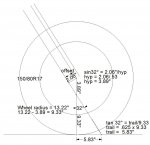1olbull
Riding Motor Since 1950
And the two values yet to find are the center of gravity location with the rider aboard and the gross weight. Then acceleration values can be used to calculate load transfer and anti-squat. And then you need to know the exact tire profiles so that you can calculate contact patch line deviation from theoretical centerline at various lean angles. Knowing all this you might begin to understand steering dynamics. Oh, and you need to know tire slip angles as well.
Actually, these dynamics are transient so any calculation is only an approximation at a given moment in time. Suspensions compress, center of gravity moves, trail changes, and anti-squat geometry varies with rear suspension travel. All these values change constantly as the bike is ridden around a curve. No given set of calculations tells the whole story of how the bike performs or how it feels. But, you will understand the system better for having performed the calculations.
One more point to ponder: Can a unicycle rider traverse a curve? How?
I'll bite -
Of course it can, we have all seen this done.
I would say that since the uni is one wheel and has no lean angle, the rider must rotate it about its axis by applying additional force to the outside pedal.
This would enable it to negotiate a curve in a series of chords and not a true radius.




